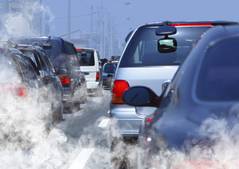AACR2013:孕妇暴露于空气污染增加胎儿癌症风险
| 导读 |
华盛顿——美国癌症研究协会(AACR)2013年会上公布的一项研究显示,如果母亲在妊娠期间曾暴露于空气污染,则其子女发生癌症的风险增加,尽管幅度不大却具有显著性。产前和1岁期间暴露于最高水平汽车尾气的儿童,发生双侧视网膜母细胞瘤和生殖细胞肿瘤的风险分别比暴露于最低水平的儿童增高19%和17%。
在这项为期9年的... |

华盛顿——美国癌症研究协会(AACR)2013年会上公布的一项研究显示,如果母亲在妊娠期间曾暴露于空气污染,则其子女发生癌症的风险增加,尽管幅度不大却具有显著性。产前和1岁期间暴露于最高水平汽车尾气的儿童,发生双侧视网膜母细胞瘤和生殖细胞肿瘤的风险分别比暴露于最低水平的儿童增高19%和17%。
在这项为期9年的病例对照研究中,加州大学洛杉矶分校菲尔丁公共卫生学院的流行病学家Julia E. Heck博士采用第4版加州线源扩散模型系统(CALINE4)检测污染。该系统使用一队机动车辆来预测汽车空转、行驶、加速和减速时的一氧化碳(CO)排放量。
研究队列为加州癌症注册处收录的3,590例儿童癌症患者。所有儿童在1998~2007年间出生,年龄<6岁。研究者将这些儿童与从加州出生记录中随机抽取的80,224例儿童进行比较。CALINE4系统基于母亲在各个妊娠期间的居住地估计当地汽车废气暴露水平。模型输入居住地1,500米半径内汽油和柴油汽车的排放量,并纳入有关交通量、道路几何形状、车辆排放率和天气模式的数据,然后根据暴露水平将研究队列按四分位数分组。研究者专门分析了CO测量值增加53/10亿的情况进行了研究。
结果显示,CO排放量每增加一个四分位数,则急性淋巴母细胞性白血病风险增加4%。各四分位数与视网膜母细胞瘤总体风险增加14%相关,双侧肿瘤(而非单侧肿瘤)风险显著增加(增加19%)。此外,CO排放量每增加一个四分位数,生殖细胞瘤风险增加17%。
CO排放量与其他肿瘤(包括急性髓性白血病、非霍奇金淋巴瘤、室管膜瘤、星形细胞瘤、神经母细胞瘤、肾母细胞瘤、肝母细胞瘤和横纹肌肉瘤)的关联不显著。
研究者表示,上述结果表明汽车废气污染与一些儿童癌症相关。由于该研究为回顾性分析,因此无法证明因果关系。研究结果需在其他研究中予以证实。
原文链接:
Prenatal exposure to air pollution boosts childhood cancer risk
WASHINGTON – Children whose mothers were exposed to air pollution during pregnancy may have a small, but significant, increase in pediatric cancer risk.
A 9-year case-control study found that children who were exposed to the highest levels of traffic-related pollution prenatally and during the first year of life were 19% more likely to develop bilateral retinoblastoma and 17% more likely to develop germ cell tumors than were children who were exposed to the lowest level.
"This is the first study to report upon traffic pollution in relation to retinoblastoma or germ cell tumors, and since both of these are rare, the findings need to be replicated in other studies," Julia E. Heck, Ph.D., said in an interview at the annual meeting of the American Association for Cancer Research.
Dr. Heck, an epidemiologist at the University of California’s Fielding School of Public Health, Los Angeles, used a state air pollution modeling system to detect the patterns in her study. The California Line Source Dispersion Modeling system, version 4 (CALINE4) uses a test fleet of motor vehicles to predict traffic-related carbon monoxide emissions from vehicles in idle, cruise, acceleration, and deceleration.
Her study cohort comprised 3,590 children with cancer who were included in a California cancer registry. All were born between 1998 and 2007 and were aged younger than 6 years. She compared these children to a random selection of 80,224 children drawn form California birth records. The CALINE4 system generated estimates of local traffic exposure based on where the mothers were living during each trimester of pregnancy.
The model imputed emissions from gasoline and diesel vehicles within a 1,500-meter radius of the address. It included data on traffic volume, roadway geometry, vehicle emission rates, and weather patterns, and divided the cohort into quartiles according to exposure. Dr. Heck looked specifically at carbon monoxide measurements in increments of 53 parts per billion.
关注转化医学网
【转化医学网 新浪微博:@转化医学网】
【转化医学网 公众微信账号:zhuanhuayixue】或扫描二维码关注微信

扫描微信二维码关注
来源:医学论坛网 腾讯登录
腾讯登录
还没有人评论,赶快抢个沙发